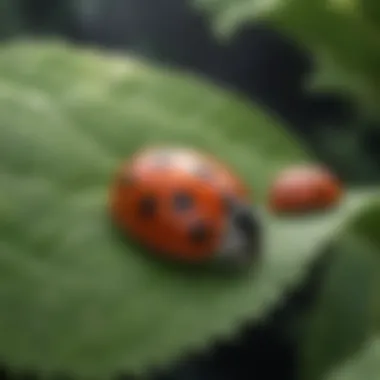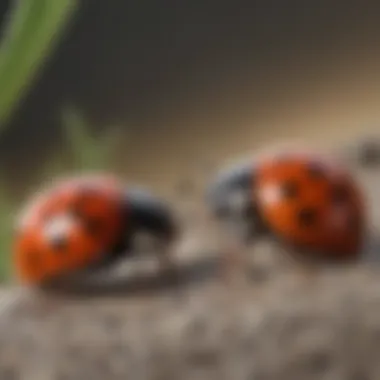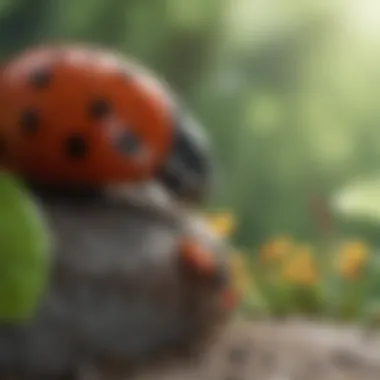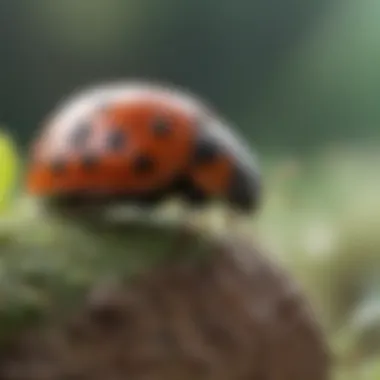Discovering the Life Cycle of Ladybug Eggs


Nature Topic Overview
Little, round, and often brightly colored, ladybug eggs are the first stepping stones in the incredible journey of these charming insects. Nestled underneath leaves, these tiny eggs play a crucial role in the life cycle of ladybugs, which are not just pretty to look at, but also valuable allies in our gardens. Their whole story from egg to adulthood unveils a fascinating dance with nature. Understanding how these eggs develop and the environment they thrive in is essential for anyone who loves nature and wants to protect it.
Fun Facts and Trivia
Did you know that ladybug eggs can be yellow or orange? These small ovals are laid in clusters, often numbering up to 20 or more! Once you spot them, you're witnessing the beginning of a new ladybug's life. Here are a few more fun tidbits:
- Quick Growers: The eggs usually hatch in just 3 to 10 days.
- Hatchlings: Once they emerge, baby ladybugs, or larvae, look quite different from their adult counterparts. They’re often black or spiky!
- Good Neighbors: Besides being cute, ladybugs are helpful pest controllers, munching on aphids and other garden nuisances.
"Ladybug larvae can eat up to 400 aphids in a week!"
Finding creative ways to learn about these fascinating critters can make the experience even more enjoyable. Think about drawing them, playing nature-themed games, or perhaps using interactive apps that teach about their life cycle.
Wildlife Explorations
There are many species of ladybugs, but a few stand out in the realm of popular recognition:
- Coccinella septempunctata: Known as the seven-spotted ladybug, it is easily recognizable with its red wings and black spots.
- Harmonia axyridis: This ladybug can show a variety of colors and patterns, making it a bit of a chameleon in the bug world.
Each ladybug plays a role in its specific habitat. In gardens, fields, or even forests, they help keep insect populations in check. Learning about their homes and habitats can be as intriguing as learning their names! For a fun challenge, you can create a quiz with your friends about the different species.
Environmental Awareness
The survival of ladybugs and their eggs is closely tied to a healthy environment. Climate change, pollution, and the loss of natural habitats are serious threats these insects face. Understanding this is important for everyone, especially kids:
- Plant gardens that encourage ladybugs, like those filled with flowers.
- Avoid pesticides that harm beneficial insects like ladybugs.
- Get involved in local conservation efforts to protect their habitats.
Even small actions can lead to significant changes. Every child can be a hero for ladybugs and other incredible creatures.
DIY Nature Activities
Here's something fun for kids and their families to try! This activity will help you make your very own ladybug habitat:
- Gather materials: You will need an aquarium or a clear container, some soil, small plants, and of course, ladybugs if you catch them!
- Create a cozy home: Fill the container with soil and add tiny plants.
- Add some ladybugs: Catch a few from your garden. Remember to check with a parent first!
- Observe: Watch how they interact and learn more about their behavior.
Nature-inspired crafts can also be a delightful way to celebrate these amazing insects. Print pictures of ladybugs, color them in, or even make a collage to showcase their vibrant red and black colors. The possibilities are endless—and that fosters curiosity and learning about the nature around us!
Preamble to Ladybugs
Ladybugs, often seen flitting about gardens and fields, are more than just charming little insects with their colorful spots. They hold a critical role in nature, serving as both predators and pollinators. This section of the article aims to shed light on the importance of these fascinating creatures and provide a foundation for understanding their life cycle, especially focusing on the next crucial stage: their eggs.
What Are Ladybugs?
Ladybugs, also known as ladybird beetles, belong to the family Coccinellidae. While they are mostly recognized by their red or orange shells adorned with black spots, some species can be yellow, black, or even shades of gray. These tiny beetles are commonly found in gardens, meadows, and agricultural fields, where they feast on pests such as aphids and mites. The diverse habitats they occupy reflect their adaptability and resilient nature. Ladybugs can be considered both friends and protectors in our gardens, helping to manage pest populations naturally. Each species has its characteristics and patterns, but they all share a common goal: to thrive and contribute to the environment.
Importance in Nature
The significance of ladybugs goes beyond their appealing looks. They play a vital role in maintaining ecological balance for several reasons:
- Natural Pest Control: Ladybugs are voracious predators that help keep pest populations in check. By controlling aphid numbers, they reduce the need for chemical pesticides, promoting healthier ecosystems.
- Biodiversity Indicators: The presence of ladybugs can indicate a healthy environment. As they enjoy clean habitats rich in plant diversity, their abundance reflects ecological well-being.
- Pollinators: Some ladybug species also contribute to pollination, assisting in the reproductive process of various plants while searching for food.
"Ladybugs are like nature's little helpers, silently working to keep gardens beautiful and ecosystems balanced."
In short, understanding ladybugs allows us to appreciate their role in the natural world. The next step involves exploring the unique aspect of their reproductive cycle—ladybug eggs. Knowing more about these eggs not only enriches our understanding of ladybug life but also highlights the importance of protecting these insects and their habitats.
Ladybug Types
Understanding the types of ladybugs is like unlocking a treasure chest of information about these enchanting creatures. Each species brings its unique touch to the ecosystem, a distinct set of colors, and varying habits. Recognizing these types can enlighten budding nature lovers about the rich biodiversity surrounding them and the roles these organisms play in maintaining ecological balance.
Common Species of Ladybugs
Ladybugs, or ladybird beetles, come in an array of species, each displaying unique colors and patterns. Some of the most common types include:


- Coccinella septempunctata (Seven-spotted ladybug): This is perhaps the most well-known ladybug, characterized by its bright red body and seven black spots. Found in gardens and fields, these ladybugs are voracious aphid eaters, making them valuable allies for gardeners.
- Harmonia axyridis (Asian lady beetle): Easily identified by its orange body with black spots, this species has gained popularity for its ability to control pest populations. They are common in North America and can often be seen clustering in homes during autumn.
- Coleomegilla maculata (Spotted ladybug): With its lavender or amber hue and distinctive black spots, this ladybug is another pest controller but also aids in pollination.
Recognizing these types can assist children in appreciating the fascinating variety of ladybug species and their differing roles in the ecosystems they inhabit.
Habitat Preferences
Ladybugs can be found in diverse environments, but they show preferences that vary by species. Some prefer gardens with abundant flowers, while others enjoy grasslands or woodlands. Here’s a brief overview of where you might encounter these little beetles:
- Garden habitats: Many ladybugs thrive in gardens, where they can find aphids to eat and plenty of flowers for nectar.
- Woodlands: Some species prefer wooded areas, often letting the shadows of trees shelter them and create a moist environment, which is favorable for laying eggs.
- Grasslands: Open fields with a mix of grasses and wildflowers provide ladybugs with suitable foraging grounds as well as hiding spots from predators.
The habitat preferences of ladybugs contribute to their overall life cycle and impact on the ecosystem, which can be an exciting aspect for children and families to explore, fostering a deeper connection to the natural world.
"Learning about ladybug types and their habitats is like going on a nature scavenger hunt. The more you know, the more you can discover!"
By diving into the different types and their habitats, children, parents, and educators can gain insights into the crucial role ladybugs play.
Exploring these aspects furthers an understanding not just of ladybugs themselves, but of how interconnected life can be, protecting this beautiful diversity we depend upon.
Ladybug Eggs: An Overview
In the world of ladybugs, understanding their eggs is crucial. These tiny, unassuming capsules hold the beginnings of one of nature's most delightful species. Ladybug eggs are not just ordinary; they play a pivotal role in the life cycle of these charming insects, setting the foundation for the next generation of garden guardians.
Ladybug eggs are usually laid in spherical clusters, often bright yellow or orange in hue. This vibrant coloration serves a significant purpose: it helps warn potential predators about their toxicity. For young readers, it's fascinating to think of these eggs almost like tiny treasure chests, each containing a future little ladybug.
Exploring where ladybugs lay their eggs and what those eggs are like unveils the resilience of these creatures in diverse ecosystems. Since these eggs must avoid a range of dangers, any clues about their nesting preferences can help us appreciate their adaptive strategies in the wild.
Where Do Ladybugs Lay Their Eggs?
When the weather warms up, ladybugs seek out safe places to lay their eggs, typically in gardens or near plants. They prefer the undersides of leaves, especially near clusters of aphids, which serve as a food source for hungry larvae once they hatch. This not only provides protection from the elements but also puts the baby ladybugs right into a rich buffet as soon as they emerge.
In areas with low predation pressure, you might observe ladybug eggs among dense vegetative growth. This placement aids in camouflage, reducing the likelihood of being discovered by birds and various other predators. However, if conditions aren’t right, like too much humidity or a lack of nearby aphids, ladybugs will search for more suitable spots, showing their adaptability in action.
"Understanding where ladybugs lay their eggs opens a door to grasping not just their life cycle but also their role in the environment."
Typical Characteristics of Ladybug Eggs
Ladybug eggs are tiny, often measuring less than a millimeter in diameter. They're typically arranged in clusters that can number anywhere from a dozen to several hundred. The eggs themselves are usually smooth and have a slightly glossy texture, giving them a shiny look to attract attention.
In terms of color, most ladybug eggs are bright yellow or orange, making them somewhat conspicuous against green leaves. This choice of color is not random; it serves as a warning that ladybug larvae, and the adults, produce toxins to deter predators. This warning coloration is a clever survival tactic, as it helps keep their eggs safer until they hatch.
As these eggs mature, they undergo a fascinating transformation. After a few days, you'll notice that they slowly change shape and color, eventually hinting at the emergence of the larvae. The transformation from egg to larvae is a critical stage of their life cycle, marking the transition from stillness into an active phase where they will become voracious eaters of aphids.
Understanding these characteristics isn’t just for science class; it helps children and curious adults alike connect with nature's amazing cycles. It emphasizes the importance of ladybugs in pest control, making them a vital component of our gardens and ecosystems.
Life Cycle of Ladybugs
Understanding the life cycle of ladybugs is crucial for comprehending how these fascinating creatures fit into our world. It gives us a glimpse into their growth and development, showcasing their journey from a tiny egg to a mature ladybug. Grasping these stages not only helps in appreciating their role in nature but also highlights the delicate balance that exists in ecosystems.
Stages of a Ladybug's Life
The life cycle of a ladybug consists of four main stages: egg, larva, pupa, and adult. Each stage brings unique characteristics and transformations that contribute to the ladybug's remarkable existence. Here’s a closer look:
- Egg Stage: The cycle begins when a ladybug lays around 10 to 50 eggs on the underside of leaves, often near aphids, which are their primary food source when the larvae hatch.
- Larva Stage: After about a week, the eggs hatch into larvae. They look quite different from adult ladybugs; they are elongated and typically black with orange spots. The larvae are voracious eaters, consuming aphids and other pests, which helps keep plant life healthy.
- Pupa Stage: Once the larvae have grown, they find a safe spot to pupate. This stage is crucial as it is when the ladybug undergoes a transformation called metamorphosis. It lasts about a week, during which the structure of the larva changes into that of an adult ladybug.
- Adult Stage: Finally, the adult ladybug emerges. At first, their wings are soft and crumpled, but they soon expand and harden. Adults can live for several months, during which they continue to eat pests and contribute positively to the agricultural ecosystem.
From Egg to Adult
This transformation from an egg to an adult ladybug is a fascinating process filled with dramatic changes. Each step is essential for the survival of the species.
At the start, the tiny eggs are typically laid on the underside of leaves, keeping them safe from predators. As mentioned earlier, the larvae are voracious eaters, growing rapidly, sometimes doubling in size within a few days. During the pupa stage, which can be likened to a transformative spa retreat, the larvae emerge with entirely new characteristics, marking a stunning evolution.
In the adult stage, ladybugs become a symbol of good luck and are adored for their colors and spots. Their life cycle not only highlights the beauty of nature's design but underscores the critical roles they play by controlling pest populations within gardens and crops.
"Nature’s way of keeping balance is truly remarkable, and ladybugs illustrate this through their life cycle."


Understanding these life stages is not just a science lesson; it’s an important reminder of how everything in nature is interconnected. As they grow, ladybugs thrive in various environments, and it’s essential to ensure they have safe, healthy habitats to continue their lifecycle.
The Role of Ladybug Eggs in the Ecosystem
Ladybug eggs might seem small and often overlooked, but they play a significant role in maintaining the balance of our ecosystem. Understanding the role that ladybug eggs play helps us appreciate the extensive webs of life in our gardens and fields. When you think of an ecosystem, it's not just plants and big animals; it's all the tiny parts, like these special eggs, that keep everything ticking along smoothly.
Predator-Prey Relationships
Let's start off by looking at the predator-prey relationships that ladybug eggs are a part of. These little eggs are the starting point for a ladybug's life, but they also function as a buffet for various bugs and creatures. Birds, spiders, and even larger insects will happily munch on these eggs if given the chance. This act not only provides nourishment for these predators, but it's also a way of controlling ladybug populations.
However, ladybug eggs have evolved to be tough little nuggets. They are sometimes laid in clusters, making them a more challenging target for hungry critters. Navally, ladybugs lay multiple eggs at once, which is sort of like having backup plans. If some eggs get eaten, others might still make it to become adults. This strategy is a brilliant adaptation, acting as a balance between predator and prey.
"In nature, every creature has its role; ladybug eggs simply provide another chapter in the story of survival."
Biodiversity and Ecosystem Health
The presence of ladybug eggs can tell us a lot about biodiversity in an area. Healthy ecosystems usually host a variety of organisms, including ladybugs. Their eggs serve as indicators of environmental quality. If you see ladybug eggs in your yard, it often means that the surrounding flora and fauna are thriving. These friendly beetles are natural pest controllers and help keep populations of harmful insects in check, which is vital for crop health and biodiversity.
The importance of ladybug eggs also extends to their eventual offspring; once they hatch, young ladybugs will seek out aphids and other pests to munch on. This natural pest management helps support the health of both gardens and agricultural lands.
Environmental Influences on Ladybug Eggs
Understanding the environmental influences on ladybug eggs is vital because it sheds light on how these tiny creatures thrive in their surroundings. These influences range from the simple, such as temperature and humidity, to the more complex interactions involving chemical exposures. Recognizing how these factors affect ladybug eggs is essential for fostering a conducive habitat and ensuring their survival.
Temperature and Humidity
Temperature and humidity are two key components that can either make or break the survival of ladybug eggs. These eggs prefer warm, moist environments that mimic the conditions of early spring. For instance, ladybugs typically lay their eggs when the temperature hovers between 15 to 25 degrees Celsius. In cooler conditions, the eggs may take longer to hatch, while excessively high temperatures can desiccate them, leading to a high mortality rate.
Humidity also plays a crucial role. When humidity is too low, the eggs may dry out before they have a chance to develop. Conversely, excessive moisture can facilitate mold growth or attract predators, which makes the eggs even more vulnerable. Experimentally, it has been observed that hatch rates can vary significantly under different humidity levels.
"The warmth of the sun in spring can coax ladybugs out of hiding and encourage them to lay their eggs. Temperature isn't just a number; it sets the stage for life!"
To foster the ideal conditions for ladybug eggs, consider creating gardens that retain moisture yet allow for good drainage. Incorporating moisture-retaining plants can regulate humidity,, providing a microenvironment that benefits these insects tremendously.
Effects of Pesticides
Pesticides pose a significant threat to ladybug eggs and the overall population of ladybugs. When a garden is treated with chemicals, it doesn't only target the pests but can also inadvertently harm beneficial insects like ladybugs. The effects of pesticides can be catastrophic; exposure may lead to reduced hatch rates or deformities in the emerging larvae.
Moreover, many pesticides linger in the environment longer than expected. This means that even if a gardener is not applying them directly at the time, remnants from past treatments can still pose a risk to the delicate life cycle of ladybugs. Studies suggest that natural alternatives, like neem oil or insecticidal soap, can hinder pests without endangering ladybugs, making them better choices for environmentally-conscious gardeners.
Using natural methods does not just protect ladybug eggs, but it helps to maintain the balance of the entire ecosystem. By promoting a pesticide-free environment, we also invite other beneficial insects, creating a more vibrant and biodiverse habitat.
Challenges Facing Ladybug Eggs
Understanding the challenges facing ladybug eggs is essential to grasping the broader narrative of their survival and the stability of ecosystems where they inhabit. As with many species, ladybug populations encounter a variety of hurdles that can impact their eggs significantly. These challenges not only affect ladybugs directly but also have a ripple effect throughout their ecosystems. Without a solid grasp on what these challenges are, it becomes difficult to appreciate the delicate balance that supports biodiversity.
Natural Predators
One prominent obstacle for ladybug eggs comes in the form of natural predators. Various insects and animals view ladybug eggs as a delicious treat. Common hunters include spiders, wasps, and even certain beetle species. The eggs are often small and vulnerable, making them easy pickings in the wild.
Here are some notable predators of ladybug eggs:
- Spiders: They set traps that can ensnare ladybug eggs while they are laid in the open.
- Wasp Species: Some wasps lay their eggs within ladybug eggs, using them as a host for their larvae.
- Ants: In some cases, ants might raid ladybugs' colonies and consume their eggs.
The presence of these predators creates a constant struggle for ladybugs. The more eggs laid, the greater the chances a few might survive, but the reality is stark: not every egg will hatch into a thriving adult. This high predation pressure means ladybug populations need to produce significantly more eggs than they can expect to survive to maturity.
Habitat Loss
Another critical issue that haunts ladybug eggs is habitat loss. Urbanization, agriculture, and industrial expansion lead to the destruction of the natural spaces where ladybugs thrive. These insects typically seek out areas rich in aphids, their primary food source, and changes in land use can severely limit their habitats.
Elements compounding the issue include:
- Deforestation: Tree removal can affect the microhabitats needed by ladybugs.
- Pesticide Use: Toxic chemicals not only kill aphids but can harm ladybugs and their eggs directly.
- Climate Change: Alterations in climate can shift the availability of suitable habitats, disrupting ladybug populations.


As suitable habitats diminish, the chance of ladybug eggs reaching adulthood greatly decreases. This loss reduces genetic diversity too, which can make populations less resilient to change.
"Every little change in our environment can have a profound impact on those who live within it. Ladybug eggs, though small, play a significant role in indicating the health of our ecosystems."
In sum, the survival of ladybug eggs is fraught with risks and challenges. The intertwined effect of natural predators and habitat loss highlights the delicate balance of the ecosystems where these creatures reside. By understanding these challenges, we can take steps to help protect ladybug populations, ensuring future generations can continue to explore and enjoy the wonders of these remarkable insects.
Conservation Efforts for Ladybugs
Conservation efforts for ladybugs are vital for maintaining the balance in ecosystems where these small yet mighty creatures thrive. The role they play in controlling aphid populations offers farmers and gardeners an eco-friendly way to protect plants. But like many species, ladybugs face challenges that threaten their survival, such as habitat loss and pesticides. Therefore, understanding conservation strategies is key not just for preserving ladybugs but also for boosting broader ecological health.
Protecting Habitats
Protecting the habitats where ladybugs thrive is essential for their conservation. These insects prefer habitats with plenty of plants, as they depend on flora not only for food but also for laying eggs and seeking shelter. Efforts to ensure that native plants flourish in gardens, parks, and agricultural lands can create a welcoming environment for ladybugs.
- Native Plant Gardens: Planting a diverse range of native plants attracts various insect populations, which increases food sources for ladybugs. For instance, butterfly bushes, daisies, and marigolds can be beneficial.
- Reducing Chemical Use: Many chemicals can harm ladybugs directly, or reduce the populations of the aphids they feed on. Adopting organic farming techniques is a win-win, promoting ladybug habitats and ensuring pesticide-free food for consumers.
Remember, every little bit counts; supporting ladybugs helps maintain the balance of nature!
Community Initiatives
Community initiatives play a crucial role in conserving ladybugs and their habitats. Many neighborhoods and schools are getting involved in local conservation projects. These initiatives not only help ladybugs but also encourage a spirit of environmental stewardship among children and adults alike.
- School Projects: By incorporating ladybug observation into science curriculums, students can learn about ecosystems. Schools can create ladybug gardens, teaching kids about plant life and encouraging responsible behavior towards nature.
- Community Workshops: Various nonprofit organizations host workshops on nature conservation. These events educate local residents about the benefits of ladybugs and offer strategies for creating ladybug-friendly spaces, such as backyard habitats.
- Social Media Campaigns: Engaging local communities through social media platforms can raise awareness about the importance of ladybug conservation. Creating hashtags and sharing success stories can rally people around the cause.
In essence, community involvement can spark a movement that not only helps ladybugs but also promotes overall biodiversity. Whether through school projects or social media campaigns, each contribution aids in the grand mission of conserving these beneficial insects.
Experiments and Observations
Experiments and observations of ladybug eggs provide a rare window into understanding their life cycle and behaviors. This knowledge is crucial for appreciating not only ladybugs but the entire ecosystem they inhabit. Engaging in such activities can foster a sense of connection to nature among young readers, encouraging curiosity and a desire to protect these charming creatures. By involving themselves in simple experiments, children can learn scientific principles in a fun and meaningful way.
How to Observe Ladybug Eggs
Observing ladybug eggs in their natural habitat can be both exciting and educational. To spot these tiny gems, one must first know where to look. Look closely at leaves of plants that ladybugs frequent, such as aphid-infested roses or common weeds. The eggs, which are typically yellow or orange and resemble small beads, are often found under leaves. Here are a few steps to guide the observation process:
- Choosing the Right Time: Early spring is ideal, as ladybugs start laying eggs when the weather warms.
- Gentle Examination: Look under leaves, but be careful not to disturb the area too much! Ladybugs are sensitive and might take off if they feel threatened.
- Document Findings: Use a notebook or a digital device to note the colors and shapes of the eggs observed, along with the location.
- Take Note of Hatchlings: If you’re lucky enough to see ladybugs hatch, take note of their color and size as they transform from eggs to larvae.
This process promotes observation skills and encourages a love for nature.
Simple Home Experiments for Kids
There are several fun and engaging experiments that children can do at home to learn more about ladybugs and their eggs. These activities can help to better understand the conditions that affect ladybug development. Here are a few ideas:
- Egg Incubation Experiment:
- Food Preferences Test:
- Materials Needed: A clear container, soil, ladybug eggs (if available), and a thermometer.
- Procedure: Place the ladybug eggs in the container filled with moist soil, ensuring the environment mimics natural conditions. Observe the temperature and humidity closely, making adjustments if necessary. Watch daily for any changes or hatching.
- Materials Needed: A few ladybugs, different small food sources (aphids, tiny bits of fruit, etc.), and multiple small containers.
- Procedure: Place ladybugs in separate containers with different food types and observe their preferences over a few days. Note which food they seem to enjoy the most.
These experiments not only spark curiosity but also create opportunities for deeper conversations about ecosystems, food chains, and the life cycles of all kinds of insects.
"The more we learn about ladybugs, the more we understand their role in keeping our environment healthy."
Incorporating simple home projects that focus on ladybug eggs can turn ordinary days into extraordinary learning adventures. As children engage in these experiential learning activities, they develop skills that extend beyond academics; they become stewards of the environment, cultivating an appreciation for the integrity and importance of biodiversity.
Culmination
Ladybug eggs play a critical role in the life cycle of these charming insects. This article has explored their significance, showing not only their developmental stages but also their contribution to the greater environment. Recognizing the importance of ladybug eggs encourages a deeper respect for biodiversity. These tiny eggs, nestled often on the underside of leaves, are a pivotal starting point in the transformation into adult ladybugs, which serve as natural allies against pests like aphids.
The Significance of Ladybug Eggs
Ladybug eggs, although small, are remarkable in their function. Each female ladybug can lay up to 300 eggs at once, ensuring the continuity of her lineage. These eggs are quite distinctive, often appearing in clusters and exuding a bright yellow or orange hue, making them easy to spot for keen observers. The presence of these eggs indicates a thriving ecosystem, as ladybugs are essential for keeping pest populations under control.
When we think about the importance of ladybug eggs, we also need to consider how they are potential indicators of environmental health. Their successful development depends on suitable conditions in their surroundings, including the availability of food sources and protection from predators. Hence, a healthy population of ladybugs suggests that their habitat is well-balanced, heavily influencing the overall ecosystem.
Encouraging Exploration of Nature
Fostering an interest in the natural world is vital for young budding scientists and nature enthusiasts. By learning about ladybug eggs and their lifecycle, children can appreciate not only the beauty of these creatures but also their importance in nature's web. Encouraging exploration can be done in simple ways:
- Create a backyard habitat: Planting flowers that attract ladybugs can provide them with a safe space to thrive.
- Engage in science projects: Kids can observe ladybug eggs in the wild or document their findings in a nature journal.
- Organize nature walks: Enthusiastic parents and educators can lead children to parks or gardens where ladybugs lay their eggs, turning a mundane stroll into an educational adventure.
By engaging with the environment and paying attention to details like ladybug eggs, children learn to value each small part of the ecosystem. This understanding can grow into a lifelong commitment to preserving nature and advocating for environmental stewardship. Encouraging curiosity early on builds the foundation for future conservationists.







